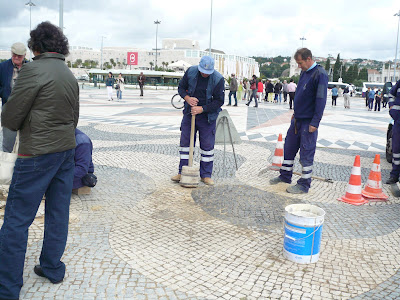

 Cristo-Rei
Cristo-Rei
After entering Lisbon, we headed to the Navigators Monument, also called the Monument to the Discoveries, and the Tower of Belem. The Torre de Belém (Tower of Belem) was built as a fortified lighthouse late in the reign of Dom Manuel (1515-1520) to guard the entrance to the port at Belém.
 Torre de Belém
Torre de Belém We could also see the Cristo-Rei from here.
We could also see the Cristo-Rei from here. Workers tiling up the pavement.
Workers tiling up the pavement. The pavement.
The pavement. Navigators Monument
Navigators Monument Side view
Side view Jeronimos Monastery
Jeronimos Monastery Jeronimos Monastery
Jeronimos Monastery Entrance of the Jeronimos Monastery
Entrance of the Jeronimos Monastery Inside of the Jeronimos Monastery
Inside of the Jeronimos Monastery Inside of the Jeronimos Monastery
Inside of the Jeronimos Monastery Tomb of Vasco da Gama, a Portugese explorer who was the commander of the first ships to sail directly from Europe to India.
Tomb of Vasco da Gama, a Portugese explorer who was the commander of the first ships to sail directly from Europe to India. The famous cafe.
The famous cafe. Bar counter of the cafe where many were lining up to buy egg tarts for take-out.
Bar counter of the cafe where many were lining up to buy egg tarts for take-out. Our delicious egg tarts and aromatic coffee. You have to sprinkle cinammon powder and sugar if you want, on the tart. And I have to tell you, it is sooooo good! One is not enough. It is so good until I dont know how to describe.
Our delicious egg tarts and aromatic coffee. You have to sprinkle cinammon powder and sugar if you want, on the tart. And I have to tell you, it is sooooo good! One is not enough. It is so good until I dont know how to describe. Grilled sardines. They are mouth-watering..and I'm not even a fan of sardines...
Grilled sardines. They are mouth-watering..and I'm not even a fan of sardines... The grilled squid. Yummy!
The grilled squid. Yummy! Grilled chicken...haiz..I'm getting hungry now..
Grilled chicken...haiz..I'm getting hungry now.. Seafood rice! Abit like seafood porridge.
Seafood rice! Abit like seafood porridge. The streets.
The streets.